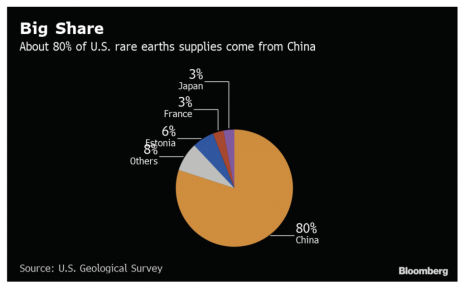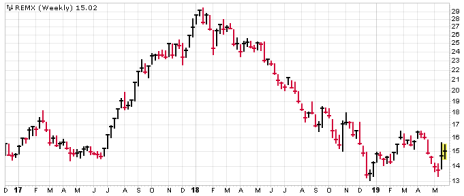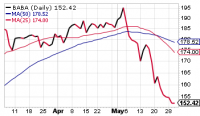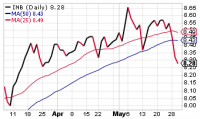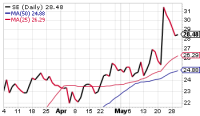It has been a busy week in emerging and global markets.
The MSCI Emerging Markets ETF (EEM) remains in a negative position, just below 20-day and 50-day moving averages. Our portfolio has a 35% cash position and maintains 10% allocation to an ETF that moves opposite the EEM.
Cabot Emerging Markets Investor 686
[premium_html_toc post_id="178402"]
Cabot Emerging Markets Timer
The Emerging Markets Timer is our disciplined method for staying on the right side of the emerging markets. The Timer is bullish when the index is above the lower of its two moving averages and that moving average is trending up.
Our Emerging Markets Timer remains negative, telling us the intermediate-term trend for most stocks continues to be down. You can see that the iShares EM Fund (EEM) has fallen off a cliff, dropping around four points as the trade war heated up. To its credit, the group has found some support near 40 in recent days, but it remains well below both of its moving averages.
In the near-term, a bounce wouldn’t be surprising, which could mark the start of a bottoming process. But until proven otherwise, it’s best to be a bit cautious when it comes to EM stocks, picking your stocks and spots carefully until a new uptrend begins.
Huawei & Rare Earths
It has been a busy week in emerging and global markets.
The MSCI Emerging Markets ETF (EEM) remains in a negative position, just below 20-day and 50-day moving averages. Our portfolio has a 35% cash position and maintains 10% allocation to an ETF that moves opposite the EEM.
Alibaba announced a new listing on the Hong Kong Stock Exchange, which in 2018 raised $37 billion for companies - more than either the Nasdaq or the NYSE. One hundred seventy-four Chinese companies have their primary listing in America.
Huawei Technologies is fighting back sanctions by filing a lawsuit marking the telecom equipment maker’s latest bid to push back Washington. The motion asks to scrap a section of the 2019 National Defense Authorization Act, which places a broad ban on federal agencies and their contractors from using Huawei equipment on national security grounds.
Huawei is China’s biggest high-tech company, and is seen as a national champion in China. Its name translates roughly as “Chinese achievement.”
Revenues of $105 billion put it in the same league as Microsoft, and only Samsung sells more smartphones. Huawei holds many crucial patents on superfast 5g mobile networks, and a commanding 70% global market share of telecom equipment.
Were it to go under, it would rattle China and global tech markets in a big way.
To push back against sanctions, China is playing a card I’ve been talking about for the last couple of years. It is signaling a willingness to consider holding back rare metals and rare earths from American firms and the world marketplace.
This is real hardball. It is underscored by a recent visit by President Xi Jinping to a Chinese rare earth company, blunt warnings in the Chinese press and a spike in media attention to this issue. All this is driving higher share prices for many rare earth and rare metals stocks.
As a result, the Lynas (LGO.TO) recommendation from my Rare Earth/Electric Vehicle special report released earlier this year is up 40% in the last three days! Our speculative Largo (LGORF) Vanadium mining position from Brazil has also come alive.
And this leads to bringing back our previous rare earths recommendation, which is now in an uptrend.
Featured Stock
New Recommendation: VanEck Vectors Rare Earths/Strategic Metals (REMX)
One of my favorite books is Daniel Yergin’s riveting tale of the major role oil played in the 20th century, The Prize: The Epic Quest for Oil, Money & Power.
Oil not only powered the economy, it also played a pivotal role in the century’s statecraft.
The following sentence in the book’s prologue really caught my eye.
“As we look toward the 21st century, it is clear that mastery will certainly come as much from a computer chip as from a barrel of oil.”
But what’s behind the computer chip and advanced technology that forms the backbone of so much that we take for granted in modern life?
The answer is strategic metals and, in particular, an important subset called rare earths. These vital ingredients are essential to economic growth and advancement of technology. They are also invisibly intertwined with national economic strategies, geopolitics, wealth and power.
Rare earths are the special ingredients of the age of technology. Like yeast in bread, they are required in small quantities in all sorts of products, from cell phones to advanced weapons systems, aircraft engines, robots and hybrid batteries.
Nineteen of them power your cell phone. This is a key reason why iPhones are largely sourced in China.
Rare earth elements, although not particularly rare, are very difficult, time consuming and expensive to extract and process. In addition, the refining of rare earths and many rare metals is unfriendly to the environment. It would be very difficult to get a permit to produce them in America.
The real value of these materials is their unique magnetic and electrochemical properties, which improve efficiency, performance, speed and durability for numerous technologies.
This allows for miniaturization and much lighter, stronger, resilient, and efficient components.
One example is Neodymium. Many of the magnets around you have Nneodymium in them: speakers and headphones, microphones, computer storage, and magnets in your electric car.
A lot of media attention regarding electric vehicles (EVs) has been centered on key ingredients in the battery —cobalt and lithium. But Neodymium-powered super permanent magnets are essential to EV motors.
Rare metals and rare earths are also found in high-powered industrial and military lasers and are especially important for green tech.
Since the 1990s, China has become the Saudi Arabia of rare earths as the country’s favorable geology, low-cost labor and lax environmental standards allowed it to produce about 85% of the world’s production.
After a long period of weak pricing and being off the front page, rare earths are now back in the news with prices and headlines on an upward trajectory.
VanEck’s Rare Earth/Strategic Metals (REMX) is an exchange-traded fund (ETF) launched in 2010.
It is fairly concentrated, with 21 holdings; the top 10 holdings represent 61% of assets and more than half of the holdings are Chinese companies.
REMX surged 82% in 2017, pulled back 45% in 2018—returning to its 2017 low—and now in mid-2019, it is in an uptrend again.
The electric vehicle revolution alone could power this ETF forward but the ongoing U.S.-China trade conflict could really launch this recommendation into space.
If forced into a corner, China will play the rare earths card and cut back on the amount of rare earths it allows into global markets. This could send REMX soaring. (Actually, it already is!) In addition, U.S., Japanese and Australian naval vessels now move through the South China Sea each day to challenge China’s claims that this critical waterway to global trade is China’s turf.
A flurry of Chinese media reports this Wednesday, including an editorial in the flagship newspaper of the Communist Party, raised the prospect of Beijing cutting exports of these rare earth materials.
The world’s biggest producer, China supplies about 80% of U.S. imports of rare earths, which are used in a host of applications from smartphones to electric vehicles and wind turbines.
The threat to weaponize strategic materials ratchets up the tension between the world’s two biggest economies before an expected meeting between Presidents Xi Jinping and Donald Trump at the G-20 meeting next month.
If you are long China stocks, REMX is also a great hedge on U.S.-China political risk.
This is an excellent time to build a half position. BUY A HALF POSITION.
VanEck Vectors Rare Earth/Strategic Metals ETF (REMX)
Model Portfolio
Prices as of 2:30pm
Updates
Alibaba (BABA) announced it intends to raise as much as $20 billion through a listing in Hong Kong. This follow-on share sale to its 2014 NYSE listing would provide Alibaba with capital to fund its new initiatives, like cloud computing.
A Hong Kong listing would also give mainland investors their first direct access to one of China’s biggest success stories. Trading around 150 a share, Baba is at an attractive entry point, so I encourage you to buy a half position if you have not yet done so.
Its recent strong quarter beat expectations, with 51% revenue growth year over year. I believe that BABA remains a great core China holding. BUY A HALF.
Daimler (DDAIF) has pulled back a bit over the last few weeks despite the Trump administration’s plans to delay auto tariffs by up to six months as negotiations continue.
This premier automaker is trading at only eight times forward earnings and given its cost-cutting program, positive growth revenue in emerging markets including China, expansion into electric vehicles, and 5%-plus dividend yield, I’m moving this from a hold to a buy a half position. MOVE FROM HOLD TO BUY A HALF.
ICICI Bank (INB) is doing well as the most recent addition to our portfolio. India offers both a large and youthful population (50% are under the age of 25) with potential “catch-up” growth to India as urbanization rate of about 30% is about where China was two decades ago.
On the financial front, there have been great strides made as India’s young people start to open bank accounts for the first time—there are still 191 million Indians without a bank account! ICICI is capitalizing on this emerging growth trend with a blend of 60% retail and 40% corporate business.
Its last quarter highlights its strength as retail loans were up 22% and core-operating profit surged 26%. The bank has a healthy net interest margin of 3.72% and non-performing loans were down 50%.
This is a solid bank in a promising market. BUY A HALF POSITION.
LexinFintech (LX) has not done much for us in May but I like its target market of 149 million Generation Zers (those born after 1995), who are increasingly the driving force behind China’s consumer market.
This high-growth fintech idea is currently trading at less than 10 times forward earnings projections. If you have not taken a position yet, I encourage you to take advantage of this week’s weakness to buy a half position. BUY A HALF POSITION.
ProShares Short MSCI Emerging Markets (EUM) was up this week as it moves opposite the MSCI Emerging Market ETF (EEM). This serves as a portfolio “shock absorber” given the volatility and uncertainty surrounding the U.S.-China confrontation. If you have not yet taken a position, I recommend you consider it as a cautionary measure. BUY.
Sea Limited (SE) shares were flat this week after double-digit increases the previous week. SE operates three platform businesses in gaming, ecommerce and digital payments, primarily in seven Southeast Asian markets.
Revenue for the most recent quarter was almost triple that of the same quarter last year, mainly attributable to a strong growth in digital entertainment and e-commerce. In particular, Garena, its gaming platform driven by a partnership with Tencent, had a standout quarter with revenue jumping 169% year over year and 70% quarter over quarter.
If you bought on our recommendation, you should take some profits off the table now. The stock has weathered the recent turbulence. HOLD A HALF.
Tencent (TCEHY) is now trading just above where it began the year.
Regulatory headwinds led to just 16% revenue growth in its most recent quarter though 25% growth is expected for the full year. Online ad revenue grew 26% and new category fintech was up 44%.
This is a strong and dominant company. I encourage you to buy a half position at these levels if you have not previously done so. BUY A HALF POSITION.
ZTO Express (ZTO) gained a little ground this week following first-quarter results, with top-line revenue up significantly year over year to $682 million.
The company express delivery services unit delivered 31.5% growth; parcel volume grew 41.6%, to 2,264 million.
ZTO is building an enormous, scalable platform that will further increase efficiencies and lower costs. If you are not yet on board, I encourage you to buy a half position right here. BUY A HALF POSITION.
Speculative Portfolio Recommendation
Largo Resources (LGORF) was up this week as interest in rare metals jumped alongside media attention to the U.S.-China tussle. Please keep in mind that this is an aggressive, speculative idea and play on vanadium. It remains buy a half position for speculators. BUY A HALF POSITION.
Watch List
Baidu (BIDU) treaded water this week and is now trading at 11 times forward earnings and is expected to grow revenues by 16% in the coming year.
We will watch this stock closely anticipating that its recent relatively weak quarter was a product of sharp increases in development expenses.
NIO (NIO) seems to be falling apart a bit this week after reporting a disappointing quarter and following a downgrade by Merrill Lynch Bank of America.
NIO reported revenue of $243 million, down 52% from the fourth quarter of 2018. On the positive side, ES8 shipments were impressive, hitting a better-than-expected 3,989 for the quarter, with overall deliveries at 16,461 units. That’s enough to at least keep it on our Watch List.
[premium_html_footer]
Send questions or comments to paul@cabotwealth.com.
Cabot Emerging Markets Investor • 176 North Street, Salem, MA 01970 • www.cabotwealth.com
All Cabot Emerging Markets Investor buy and sell recommendations are made in issues or updates and posted on the Cabot subscribers’ website. Sell recommendations may also be sent to subscribers as special alerts via email. To calculate the performance of the hypothetical portfolio, Cabot “buys” and “sells” at the midpoint of the high and low prices of the stock on the day following the recommendation. Cabot’s policy is to sell any stock that shows a loss of 20% in a bull market (15% in a bear market) from our original buy price, calculated using the current closing (not intra-day) price. Subscribers should apply loss limits based on their own personal purchase prices.
THE NEXT CABOT EMERGING MARKETS INVESTOR ISSUE IS SCHEDULED FOR June 13, 2019
We appreciate your feedback on this issue. Follow the link below to complete our subscriber satisfaction survey: Go to: www.surveymonkey.com/chinasurvey
Cabot Emerging Markets Investor is published by Cabot Wealth Network, an independent publisher of investment advice since 1970. Neither Cabot Wealth Network, nor our employees, are compensated in any way by the companies whose stocks we recommend. Sources of information are believed to be reliable, but they are in no way guaranteed to be complete or without error. Recommendations, opinions or suggestions are given with the understanding that subscribers acting on information assume all risks involved. © Cabot Wealth Network 2019. Copying and/or electronic transmission of this report is a violation of the copyright law. For the protection of our subscribers, if copyright laws are violated, the subscription will be terminated. To subscribe or for information on our privacy policy, visit www.cabotwealth.com, write to support@cabotwealth.com or call 978-745-5532.
[/premium_html_footer]





